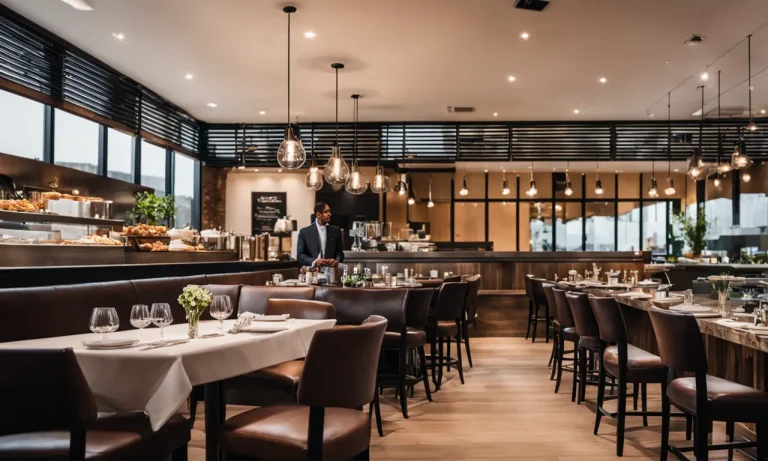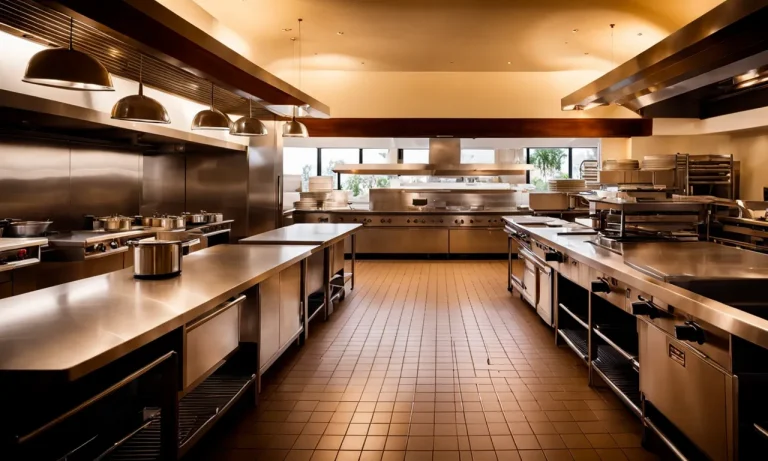Working as a restaurant server can be a rewarding yet demanding job. If you’ve ever wondered how much money servers take home in tips each night or year, you’re not alone. In this comprehensive guide, we’ll break down exactly how restaurant servers get paid and how much they earn on average.
If you’re short on time, here’s a quick answer to your question: Restaurant servers typically earn $10-$30 per hour in tips, which accounts for the bulk of their take-home pay. Their hourly wages from employers are lower, usually around $2-$5 per hour since tips allow employers to take a ‘tip credit’ and pay below minimum wage.
So in total, servers earn $12-$35 or more per hour on average.
The Basics of How Restaurant Servers Get Paid
Working as a restaurant server can be a rewarding job, but understanding how servers get paid is essential for anyone considering this line of work. While the specifics may vary from one establishment to another, there are some common elements that can help shed light on this topic.
Servers Rely Mainly on Tips, Not Hourly Wages
Unlike many other professions, restaurant servers rely heavily on tips as their main source of income. While they do receive an hourly wage, it is typically much lower than the minimum wage set by law. This is because it is expected that tips will make up the majority of a server’s earnings.
According to the United States Department of Labor, the federal minimum wage for tipped employees is $2.13 per hour. However, if a server’s tips do not bring their total earnings up to the regular minimum wage, the employer is required to make up the difference.
Typical Pay Structures and Tip Credit/Tip Pool Policies
The specifics of how servers are paid can vary depending on the restaurant and local laws. Some restaurants may have a tip credit policy, which allows them to pay servers an even lower hourly wage as long as they make up the difference in tips.
Others may have a tip pool system, where servers share their tips with other staff members such as bussers or bartenders.
It’s important for servers to understand their restaurant’s policies regarding tips, as well as any applicable labor laws in their area. This can help ensure that they are receiving fair compensation for their work.
Factors That Influence Average Tip Amounts
The amount of money a server can make in tips can vary greatly depending on a variety of factors. Some of these factors include the type of restaurant, the location, the time of day, and the level of service provided.
For example, servers at high-end restaurants in major cities may earn significantly more in tips compared to those working at casual dining establishments in smaller towns.
According to a study conducted by the National Restaurant Association, the average tip percentage in the United States is around 15-20% of the total bill. However, it’s important to note that this can vary depending on individual preferences and cultural norms.
It’s also worth mentioning that while tips are often given in cash, some establishments may allow customers to add a tip to their credit card payment. In these cases, the server would typically receive their tips as part of their paycheck.
Average Hourly and Annual Income for Servers
Hourly Wages and Tips While Working
Restaurant servers typically earn a combination of hourly wages and tips while working. The hourly wage for servers can vary depending on the establishment and location. According to the Bureau of Labor Statistics, the median hourly wage for servers in the United States is $11.42.
However, it’s important to note that this figure does not include tips, which can significantly increase a server’s overall income.
Tips are a crucial part of a server’s earnings, and they can vary greatly depending on the restaurant, the quality of service provided, and the generosity of the customers. It’s not uncommon for servers to make a substantial amount of their income from tips.
In fact, some servers have reported earning an average of $20 to $30 per hour, or even more during peak times or at high-end establishments.
Annual Salary Ranges Based on Experience
When looking at the annual income for servers, it’s important to consider factors such as experience and the type of restaurant they work in. Servers with more experience and who work at upscale establishments generally earn higher salaries compared to those just starting out or working at smaller, casual dining establishments.
According to the National Restaurant Association, the average annual income for servers in the United States ranges from $22,000 to $42,000. However, it’s worth noting that these figures can vary significantly depending on factors such as location, restaurant reputation, and the server’s ability to provide excellent customer service.
How the Pandemic Impacted Server Pay
The COVID-19 pandemic had a significant impact on the income of restaurant servers. With many restaurants forced to close or operate at limited capacity, servers experienced a decrease in the number of shifts available and a decline in customer traffic.
This resulted in a decrease in tips and overall earnings for many servers.
According to a survey conducted by the Economic Policy Institute, the average weekly earnings for food and beverage servers decreased by 61% during the pandemic. This decrease in income has placed a financial strain on many servers who rely heavily on tips to make a living.
As the industry continues to recover from the effects of the pandemic, servers are hopeful for a return to pre-pandemic earning levels. With the reopening of restaurants and the return of customers, servers are optimistic about their future income prospects.
For more information on server income and industry trends, you can visit websites such as Bureau of Labor Statistics and National Restaurant Association.
Restaurant Server Pay by State and City
States With the Highest Average Server Pay
When it comes to restaurant server pay, not all states are created equal. Some states have higher average wages for servers, making them more attractive destinations for those in the industry. According to the latest data from the Bureau of Labor Statistics, the states with the highest average server pay include:
- Washington, D.C.
- Hawaii
- Massachusetts
- California
- Oregon
These states have consistently ranked among the top in terms of server wages. In Washington, D.C., for example, servers can earn an average hourly wage of over $15, while in Hawaii, the average hourly wage is around $14.
These higher wages can be attributed to factors such as higher cost of living and a higher demand for restaurant services in these areas.
Metro Areas and Cities With the Most Lucrative Server Jobs
While some states may offer higher average server pay, certain metro areas and cities within those states stand out as particularly lucrative for restaurant servers. These cities not only offer competitive wages but also attract a large number of tourists and have a thriving restaurant scene.
Some of the metro areas and cities with the most lucrative server jobs include:
- San Francisco, California
- New York City, New York
- Las Vegas, Nevada
- Los Angeles, California
- Miami, Florida
In cities like San Francisco and New York City, servers can earn higher wages due to the higher cost of living and the demand for quality dining experiences. In Las Vegas, where the tourism industry is booming, servers often receive high tips from visitors who are looking to enjoy the city’s vibrant nightlife.
These cities offer not only competitive wages but also the opportunity for servers to work in renowned restaurants and establish their careers in the industry.
It’s important to note that these rankings can change over time, so it’s always a good idea for servers to stay informed about the current trends and opportunities in their respective areas. For more detailed and up-to-date information on server pay by state and city, you can visit the Bureau of Labor Statistics website.
Pros and Cons of Working as a Restaurant Server
Advantages of Server Jobs
Working as a restaurant server can bring a variety of benefits and advantages. Here are some of the key advantages to consider:
- Flexible Work Schedule: One of the greatest advantages of being a restaurant server is the flexibility it offers. With shifts available during both day and evening hours, servers can often find a schedule that works for them, allowing them to pursue other interests or responsibilities.
- Tips and Earnings Potential: Restaurant servers have the opportunity to earn tips, which can greatly increase their overall earnings. While the amount can vary depending on the establishment and the level of service provided, skilled servers who provide exceptional customer service have the potential to earn a significant income.
- Fast-Paced and Dynamic Work Environment: For those who enjoy a fast-paced and dynamic work environment, working as a restaurant server can be an exciting career choice. Interacting with customers, taking orders, and serving food and drinks requires quick thinking and the ability to multitask effectively.
- Opportunities for Advancement: Many successful restaurant professionals have started their careers as servers. Working in the industry allows individuals to gain valuable experience and knowledge, opening doors for advancement to positions such as restaurant managers or even restaurant owners.
Potential Drawbacks to Consider
While working as a restaurant server has its advantages, there are also some potential drawbacks to consider before pursuing this career path:
- Physical Demands: Serving tables can be physically demanding, requiring servers to be on their feet for long periods of time and carry heavy trays. It is important to be physically fit and take care of one’s health to handle the demands of the job.
- Irregular Income: While tips can significantly boost a server’s income, it can also be unpredictable. Servers may experience fluctuations in earnings based on factors such as the season, the day of the week, or even the mood of the customers. It is essential to budget and plan finances accordingly.
- Dealing with Difficult Customers: As a server, one must be prepared to handle difficult customers or challenging situations. Dealing with complaints, resolving conflicts, and maintaining a positive attitude can sometimes be challenging.
- Work-Life Balance: The nature of the restaurant industry often means working evenings, weekends, and holidays when others may be enjoying time off. Achieving a work-life balance can be challenging for individuals with family or personal commitments.
Understanding the pros and cons of working as a restaurant server is crucial in making an informed decision. It is important to weigh these factors and consider personal preferences and goals before embarking on a career in the food service industry.
Starting a Career as a Restaurant Server
If you have a passion for food and enjoy providing excellent customer service, starting a career as a restaurant server can be a rewarding choice. As a server, you will have the opportunity to interact with customers, take their orders, and ensure they have an enjoyable dining experience.
However, before you can start serving tables, there are a few steps you need to take.
Training and Getting Hired as a New Server
Many restaurants require their servers to undergo training to learn the necessary skills and protocols. This training may include learning about the menu, proper etiquette, and how to handle different customer situations.
Some restaurants may also require servers to obtain a food handler’s certificate.
To get hired as a new server, it is important to have a friendly and outgoing personality. Restaurants are looking for individuals who can provide exceptional customer service and create a positive atmosphere for guests.
Having good communication and multitasking skills is also beneficial in this role.
When applying for server positions, it’s a good idea to have a well-prepared resume that highlights any previous experience in the food and beverage industry. Previous experience as a server or in a similar customer service role can give you an advantage during the hiring process.
Advancing to Higher Paying Positions
While starting as a server may not always offer the highest pay, there are opportunities for advancement within the industry. Many servers go on to become shift supervisors, assistant managers, or even restaurant managers.
These positions often come with higher salaries and additional responsibilities.
To advance in your serving career, it’s important to continuously improve your skills and knowledge. Taking on additional responsibilities, such as training new servers or assisting with inventory management, can demonstrate your dedication and commitment to your role.
Seeking out opportunities for professional development, such as attending workshops or obtaining certifications, can also enhance your chances of moving up within the restaurant industry.
It’s worth noting that the amount a restaurant server makes can vary depending on factors such as the type of restaurant, location, and level of experience. While some servers may earn a base wage, the majority of their income often comes from tips.
It’s important to provide excellent service and strive to exceed customer expectations to maximize your earning potential as a server.
For more information on starting a career as a restaurant server, you can visit www.servetips.com or www.restaurant.org.
Conclusion
Working as a restaurant server can provide a comfortable income through tips, which often exceed hourly wages. Exact pay varies based on the restaurant, location, and your experience level, but servers can expect to earn $12-$35 or more per hour on average.
While the work is fast-paced and demanding, server positions offer flexibility and opportunities to earn cash daily in tips. With the right skills and work ethic, dedicated servers can excel in customer service and earn excellent pay over time in this role.






